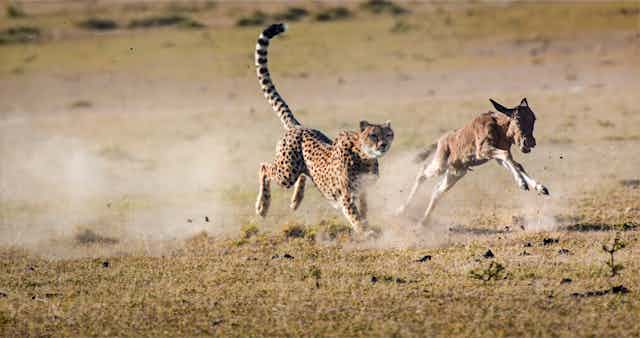We’re here to reveal another side to “nature, red in tooth and claw”. Predators are commonly perceived as being ferocious successful hunters and their prey as having little or no chance of survival once the hunt is on. The truth however, is that hunts often fail. Even for the most powerful and formidable predators, failure is more common than success.
The Hunt, a new OU/BBC series produced by Silverback Films and narrated by David Attenborough, looks at different habitats and the challenges each presents to both predators and prey. The show highlights how wild animals can only be understood by considering the habitat in which they evolved. While stealth, ingenuity or camouflage may work in one environment, stamina, strength or speed may be needed in another.

Both predators and prey are caught up in an “evolutionary arms race” where over time predators evolve traits that make them better hunters and prey evolve more effective defenses to evade capture, and so on. So, for an antelope that relies on speed and agility to avoid capture, only the fastest, most agile survive but the same also applies to their predators.
The upshot is that both predator and prey become better adapted, but neither attain a significant survival advantage over the other. As the Queen said to Alice in Lewis Carroll’s Through the Looking Glass: “It takes all the running you can do to stay in the same place”. This is known as the Red Queen hypothesis: organisms constantly evolve to keep up with their opponents who themselves evolve in response.
The series, which we worked on as academic consultants, captures hunting behaviour that has not been filmed and in some cases not even seen before: polar bears climbing 300 metres up a cliff in search of chicks and eggs; Darwin’s bark spider, only described in 2010, constructing a web by spraying a strand of silk 25 metres across a river to serve as a bridging line from which the web is hung (the silk is ten times stronger than Kevlar, the material used in bullet-proof jackets); and footage of Arctic foxes leaping vertically into the air, plucking auks out of the sky.
Cheetahs are nature’s sports cars
The series’ “car chase” footage of African wild dogs, achieved using gyro-stabilised camera mounted on a vehicle, puts you alongside the pack as they hunt. It illustrates why they are the most successful hunters on the plains and can bring down prey ten times their size: they hunt in co-ordinated packs led by a dominant individual and have immense stamina, travelling up to 60 km/h for up to 5 km.

Unlike wild dogs who depend on stamina and cooperation, cheetahs are mostly solitary hunters relying on speed and agility. They are recognised as the fastest land mammal on earth. A recent study of naturally hunting cheetahs recorded a male, named Ferrari, at a top speed of 93 km/hr (58 mph).
But in spite of their ability to run incredibly fast, cheetahs rarely hunt at top speed; to be successful, they have to balance pace with the agility needed to catch animals like gazelles that use quick turns as an escape tactic. When going flat out, cheetahs can’t track these turns efficiently. They therefore make a trade off – speed for manoeuvrability – which is a common strategy in biological systems.
The slow motion photography used to film their hunts gives a sense of both nimbleness and speed but also their astounding power – 120 watts per kg of muscle – twice that of greyhounds and four times that of racehorses. Usain Bolt generated just 25 watts/kg during his 100 metre world record.
It’s not just big mammals
The series also explores the tactics of some smaller, less familiar predators. Jumping spiders of the genus Portia feed on other spiders and display remarkably complex and flexible hunting behaviour for an animal with a brain made up of just a few neurons.

In fact their capacity to innovate and learn is more reminiscent of dogs and cats. Their hunting behaviour is visually guided and includes aggressive mimicry, a form of deception where, on locating a spider, they manipulate the web by plucking it, imitating a small ensnared insect. Portia can generate an almost unlimited number of signals and adjusts them in response to feedback from prey. In other words, they derive signals through trial and error – problem-solving behaviour you wouldn’t expect from a spider.
If deception doesn’t work Portia switches tactic, planning the route to its prey and taking detours even when direct paths are available. For example when approaching a spitting spider they approach from the rear even if this means going out of their way. But even this behaviour is flexible, as spitting spiders that are carrying eggs and cannot spit are approached head on. Making pre-planned detours when hunting prey is the sort of sophisticated behaviour you see in lions; it seems by making best use of limited brain resources a small spider can achieve a predatory strategy that rivals that of a large mammal.
Predators under threat
The Hunt makes one acutely aware that many of the animals featured and many others on Earth are under threat because of conflict with humans. The final programme in the series addresses some of the conservation initiatives around the world that recognise many iconic predators are struggling to survive in a world that, for them, is shrinking rapidly.

Co-existing with big predators is possible, but requires commitment, compromise and dedication. Without concerted effort, large iconic predators such as lions, leopards, polar bears and harpy eagles as well as many small but equally important ones, could disappear completely from the wild.
The new series presents predators in a refreshing and thought-provoking way – they are not just relentless killers but animals that work hard for a meal, relying on stealth, stamina, speed, ingenuity, cooperation and sometimes just luck. At times, instead of rooting for the hunted, you’ll find yourself cheering on the hunter.

